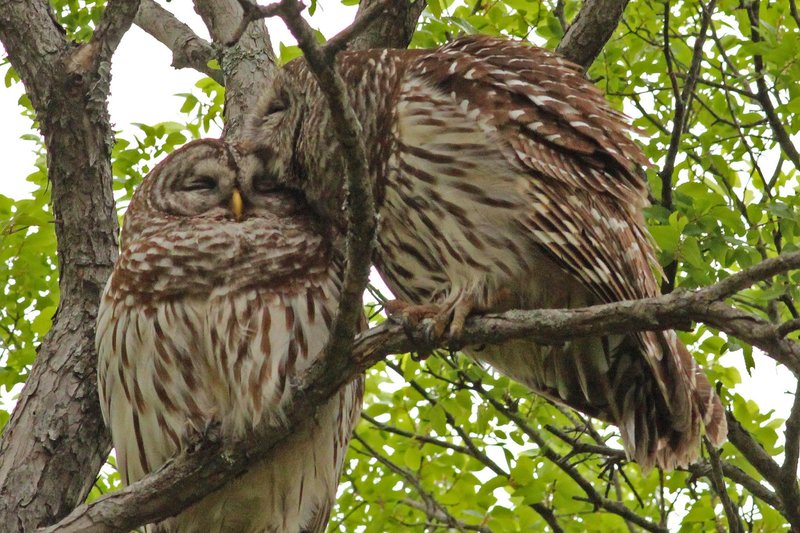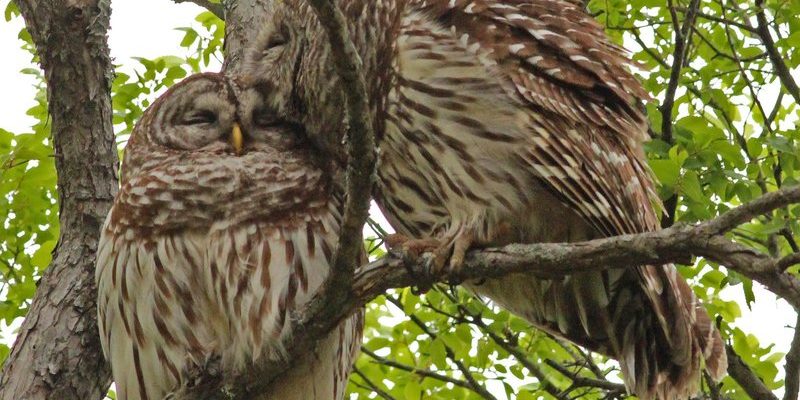
Imagine a romantic comedy where the main characters have to go through a series of hilarious but meaningful interactions to see if they’re truly compatible. That’s somewhat how it works for barred owls during their mating season! From vocal serenades to elaborate displays, these owls have developed unique ways to connect with each other. So, let’s delve into their world, breaking down these rituals like you’re chatting with a friend over coffee.
Understanding Barred Owls
Before jumping into their courtship, it’s essential to know a bit about barred owls themselves. These majestic birds are easily recognized by their distinctive “barred” feather patterns and bright yellow eyes. Found primarily in North America, they thrive in old-growth forests and are known for their haunting calls that echo through the night.
Barred owls are medium-sized raptors, typically measuring about 16 to 25 inches in length. They have a varied diet, mainly feeding on small mammals, birds, and occasionally reptiles. Their versatility in hunting and adaptability to various habitats make them fascinating subjects for study in the animal kingdom.
These owls are also monogamous, often forming lifelong bonds with their mates. This steadfast approach to relationships plays a significant role in how they express affection and ensure the success of their breeding season.
The Importance of Vocalizations
You might be wondering how barred owls find and attract each other. Well, they’re not shy about using their voices! Vocalizations are crucial during courtship, and the barred owl has an impressive repertoire of calls.
During the breeding season, which typically occurs from late winter to early spring, males begin to call out to attract potential mates. Their signature “Who cooks for you? Who cooks for you-all?” is not just a dinner invitation; it’s an announcement of their presence and fitness as a mate.
Females respond with their own calls, indicating their interest. This back-and-forth vocal exchange can be likened to a dance of sorts, where each call serves to affirm their connection and compatibility. The better the male’s calls, the more attractive he becomes to potential mates, just like a charming serenade in a romantic movie.
Visual Displays in Courtship
Besides their calls, barred owls also engage in various visual displays to woo their partners. You might catch them puffing up their feathers, bobbing their heads, or flashing their wings—acts that signal strength and vitality to a prospective mate.
You can think of these behaviors like a peacock fanning its feathers. The larger and more vibrant the display, the more likely it is to catch the eye of a female. For barred owls, showing off their size and health can be a decisive factor during mating season. Males often perform these displays while perched in a high spot, showcasing their impressive stature and ensuring visibility.
Additionally, you might see pairs preening each other, which deepens their bond and establishes trust. These moments of affection help strengthen their partnership, ensuring both members feel secure and connected as they prepare for nesting.
Nesting and Pair Bonding
After the initial courtship rituals, once a pair has formed a bond, they’ll begin looking for a suitable nesting site. Barred owls typically prefer cavities in trees or abandoned nests from other birds. Here’s the thing: site selection plays a critical role in their reproductive success.
Once they settle on a location, the female starts laying eggs, usually ranging from two to four. The male assists during this time by providing food and protection, reinforcing their partnership. They work together to ensure the safety of their nest, which is often a hectic birdsong-filled period as they defend against potential intruders.
One remarkable aspect of barred owls is their ability to adapt nesting sites based on their environment. For instance, in areas with heavy human activity, they might choose more secluded spots to minimize disturbances. This adaptability showcases their intelligence and resilience, essential traits for survival.
Raising the Young
Once the eggs hatch, things get even more exciting. The parents take turns caring for the owlets, ensuring they get enough food and protection from predators. This stage is crucial for both parents to bond even more, showcasing their commitment to each other and the offspring.
You might be curious about the owlets themselves. They’re initially small and helpless, fully relying on their parents for survival. As they grow, they’ll start to develop their distinctive feather patterns, which help them blend into their wooded surroundings.
It’s a busy time for barred owl parents! They must teach the young ones how to hunt and navigate their environment. This process can take several months, and once the owlets are ready for independence, they’ll leave the nest, carrying forward the instincts their parents instilled in them.
The Barred Owl’s Role in Ecosystems
Barred owls aren’t just fascinating for their romantic rituals; they play a vital role in their ecosystems. As predators, they help control populations of small mammals and other birds, maintaining balance in their habitats. This balance is crucial for the health of forest environments.
You could say that their courtship and parenting behaviors add another layer to their ecological role. By successfully raising their young, they ensure that future generations continue to thrive. The health of their populations impacts other wildlife and plants in the area, demonstrating the interconnectedness of nature.
Understanding barred owls and their courtship rituals gives us a glimpse into the intricate web of life in our forests. It’s a reminder that every species has a role to play, and their stories are worth appreciating.
In the grand tapestry of nature, the barred owl stands out not just for its striking appearance but for its rich courtship and mating rituals. From their melodious calls to their captivating displays, these owls embody a blend of romance and practicality in the wild.
As you explore the world of barred owls, remember that their courtship isn’t just about finding a mate; it’s about forging lasting partnerships that contribute to the ecosystem’s health. Next time you hear their haunting calls on a quiet evening, take a moment to appreciate the love story unfolding in the treetops. The rituals of barred owls remind us that nature has its own beautiful way of connecting, thriving, and ensuring the future.

